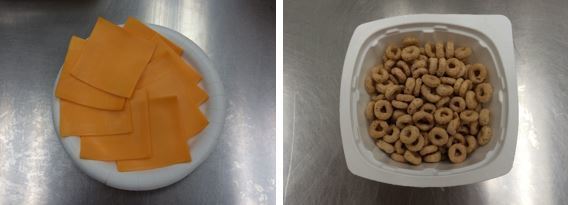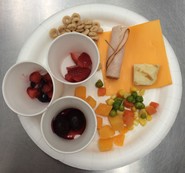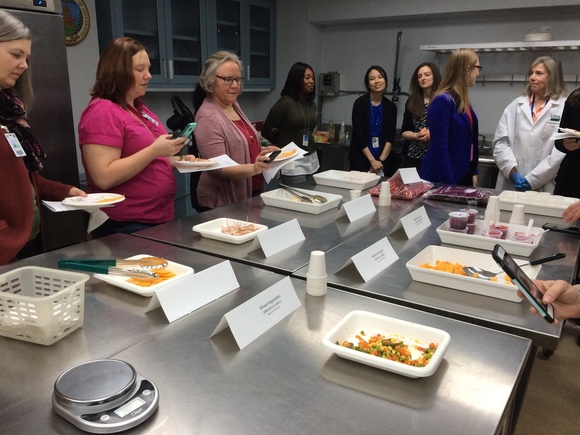School Year 2019-2020 Foods Available List
On December 18, 2018, the School Year 2019-2020 USDA Foods Available List for Schools and Institutions was published. Each year, USDA works diligently to introduce new products and reformulate items based on feedback from states and school districts. This year, we are pleased to unveil four new products for ordering in the upcoming school year, including frozen sweet cherries, sliced cheddar cheese, one-ounce bowls of toasted oats, and blue cornmeal. In addition to these new items, we added smaller package sizes of frozen peaches, green beans, and corn to better meet the needs of school districts. Finally, we reintroduced three enriched grain items to provide flexibility to school districts in their menu planning, including all purpose flour, spaghetti, and long grain rice. Check out the new product preview sheets to learn more about each of these items! At USDA, we strive to publish a list of items that meets the unique needs of school districts across the country by closely monitoring trends and adapting our list of offerings. To submit new product ideas or provide feedback on existing products, email us at USDAFoods@fns.usda.gov.
 |
USDA Foods sliced cheddar cheese and toasted oats bowl, new for School Year 2019-2020!
Trade Mitigation Purchases for Schools
As part of the Administration’s Trade Mitigation program, USDA will administer a Food Purchase and Distribution Program to purchase up to $1.2 billion of USDA Foods. The specific products to be purchased are those impacted by the tariffs imposed by other nations.
USDA will purchase products in four phases with deliveries for The Emergency Food Assistance Program (TEFAP) starting in January 2019 and going through December 2019. The full range of products will be offered to TEFAP and many of those offerings and purchases have been made for phases one and two.
Several products will be offered to schools to order in February-March 2019 for deliveries starting in July and going through December. This plan will align with the typical USDA Foods in Schools ordering schedule and allow deliveries early in School Year 2019-2020.
USDA's Food and Nutrition Service (FNS) and Agricultural Marketing Service (AMS) are working closely to select products that can be most readily used by schools, are in appropriate pack sizes, and are available in large enough quantities. Products expected to be offered and purchased for schools under Trade Mitigation include pork, apples, oranges, kidney beans, and potatoes. This plan may change depending on market conditions or other factors.
More information on the overall Trade Mitigation Program can be found in this USDA Press Release from August 27, 2018.
2019 Show Us Your Tray Photo Contest
Thank you to everyone who submitted photos for the 2019 Show Us Your Tray Photo Contest! The photo contest closed on January 15, 2019, and we want to congratulate all of the school districts that showcased how they creatively use USDA Foods to make kid-approved school meals. We received more than 250 photos from school districts across the country, and the photos we received are impressive! This year, we offered four different categories for school districts to highlight their school meals, and one winner will be selected for each of the following categories:
- USDA Foods Gold Tray Award
- Protein Power Award
- Great Grains Award
- Say Cheese Award
Visit our website to learn more about each category.
The winners of the 2019 Show Us Your Tray Contest will be announced in a special edition of the USDA Foods from Farm to Plate e-letter, at the School Nutrition Association (SNA) Legislative Action Conference, at the American Commodity Distribution Association (ACDA) Annual National Conference, and on the USDA Foods website!
Make sure you are subscribed to the Food Distribution – USDA Foods in Schools GovDelivery newsletter topic to receive the special edition announcing the 2019 Show Us Your Tray Photo Contest winners!
Photo from the 2017 Show Us Your Tray Contest: Beef Vegetable Soup, Grilled Cheese, Salad, and Peaches Cup
Frozen Sweet Cherries
Did you know there are different types of cherries produced in the United States? While USDA Foods has offered tart cherries to schools previously, this year schools can select frozen sweet cherries in addition to the tart cherry options. Sweet cherries tend to be larger and have darker skin than tart cherries. They are also naturally sweet, so no sugar is added to these frozen treats. This item will come pre-pitted and individually quick frozen, so it can be used whole in fruit salads or fruit cups, or put into smoothies, syrups or sauces. Be sure to check this out for your school lunch and breakfast needs next school year!
USDA Foods in Schools Taste Test for State Distributing Agencies
In December, USDA hosted State Distributing Agencies for a day and a half training that included a taste test of USDA Foods. More than 50 individuals from State agencies across the nation visited the test kitchen at the USDA South Building. During their visit, attendees learned how the Food and Nutrition Service (FNS) works with the Agriculture Marketing Service (AMS) to add new foods to the Foods Available List and how to reformulate existing items. Attendees tasted nine different USDA Foods items and got a first look at three new products on the recently released School Year 2019-2020 Foods Available List. Below are the items State agencies tried during the taste test:
- Mixed Berries, Cups, Frozen – 110859
- Cherries, Sweet, Pitted, Unsweetened, Frozen (IQF) – 110872 *new item*
- Strawberries, Sliced, Frozen, Unsweetened (IQF) – 110860
- Mixed Vegetables, No Salt Added, Frozen – 110871
- Squash, Butternut, No Salt Added, Frozen – 110861
- Chicken, Grilled Fillet, 2.0 MMA, Unbreaded, Frozen – 110921
- Turkey, Deli Breast, Smoked, Sliced, Frozen – 110910
- Cheese, Cheddar, Yellow, Sliced Chilled – 111110 *new item*
- Cereal, Oat Circles, Bowls – 111100 *new item*

The test kitchen buzzed with excitement as state agency staff tried each food item and evaluated its overall taste, texture, and appearance. Eight out of nine taste test items received an average rating of 4.3 or higher on a scale of 1 (poor) to 5 (excellent) on its taste, texture, and appearance.
Attendees provided great feedback, appreciated learning more about the process, and were interested in providing more opportunities for School Food Authorities (SFAs) to review items on the Foods Available List.
Taste tests are a great way to market USDA Foods and engage school districts and food service staff. If State agencies are interested in hosting a USDA Foods taste test and need assistance, please submit a request to USDAFoods@fns.usda.gov.
|
 |
On November 2, staff from the Missouri Department of Education, Food and Nutrition Services hosted a creative and colorful booth at the Missouri School Nutrition Association meeting. The booth featured USDA Foods banners, copies of the Foods Available List for Schools, and sample forms for the Team Nutrition kids food critic activity. Staff provided technical assistance to school districts and samples of the individual portion packages of USDA Foods dried cranberries!

On November 7, USDA employees visited the Montgomery County Schools’ central production facility as well as Forest Oak Middle School in Maryland. The group witnessed firsthand how kitchen staff managed inventory and prepared meals at the central production facility, shedding light on the variety of tasks that go into providing food to schools. The facility prepares breakfast, snacks, and boxed meals and provides supplies and nutritional information to schools that prepare their own meals.
 |
|
After seeing how much work went into the preparation, USDA employees saw students eating the meals. Middle school students walked through the lunch line choosing between a variety of vegetables, main courses, and other options. USDA staff then got their own opportunity to try the foods, tasting pizza and cauliflower (pictured to the left) at Forest Oak Middle School and an array of foods at the central production facility, such as butternut squash soup, spinach dip, and tacos. These foods were both delicious and nutritious. This opportunity allowed staff to see firsthand the inventiveness that goes into using USDA Foods. |
The School Year 2020 catalog is open and the Trade Mitigation catalog will open soon. Now is an opportune time to review best practices for inventory management. The number one rule of thumb is: Only order what you need and your Recipient Agencies (RA) can use. Proper inventory management will ensure that USDA Foods are distributed in an efficient, timely manner, and in optimal condition. Proper handling and storage of USDA Foods throughout the distribution chain is essential to maintain product quality and food safety. Here are a few best practices:
Receiving
- Inspect the product as it is received, open cases, and, if needed, open internal packaging to check product at the time of delivery.
- Date product with day it was received and adhere to the product dates provided by the manufacturer.
- Take action immediately if product does not meet specifications. Document and report any issues with supporting photos. RAs should report all USDA Foods complaints to the State Distributing Agency (SDA). SDAs should report all USDA Foods complaints through the Web-Based Supply Chain Management System (WBSCM).
- Train warehouse and school food service staff on how to properly receive and store USDA Foods.
Storing
- Store product properly. Certain products such as dried fruits, grain products, yogurt, and cheese are more sensitive to storage conditions. These types of items should be stored in a cool, dry place at refrigerator or freezer temperatures, and should be distributed to program recipients as soon as possible.
- Stock should be rotated, utilizing FIFO (“First In - First Out”).
- Maintain sanitary conditions, proper temperatures and humidity, and adequate air circulation.
- Ensure that storage facilities have obtained all required Federal, State, and/or local health inspections and/or approvals and such inspections/approvals are current.
- Determine an effective schedule for product distribution.
For more information, review:
The Complaint Team is available Monday-Friday, 6:00 a.m. – 5:00 p.m. Eastern Time.
USDA staff will be participating in these upcoming meetings in 2019. We look forward to meeting you and hope to see you there!
February 24-26: School Nutrition Association (SNA) Legislative Action Conference in Washington, DC.
May 5-8: American Commodity Distribution Association (ACDA) Annual National Conference in Niagara Falls, New York.

1. Click here. Or you can go to the Food Distribution website and click on the red envelope on the row of social media icons on the top right of the page.
2. Enter your email address and click "Submit."
3. Check the boxes to select your topic(s) of interest. For these e-letters, scroll down to the Food Distribution category and click the plus sign to the left of the check box to expand the list and view all the topics. Select any of these topics to receive the general e-letter plus the corresponding program-specific e-letter(s) of your choice:
*USDA Foods --> receive all "USDA Foods from Farm to Plate" e-letters
*Commodity Supplemental Food Program (CSFP) --> receive "Household Highlights"
*The Emergency Food Assistance Program (TEFAP) --> receive "Household Highlights"
*Food Distribution Program on Indian Reservations (FDPIR) --> receive "FDPIR Connection"
*USDA Foods in Schools --> receive "Spotlight on Schools"
4. Visit the subscriber preferences page any time you would like to review, add, or delete subscriptions. Questions? Contact USDAFoods@fns.usda.gov.
5. Share the e-letter and new subscriber link with interested colleagues and friends!
|
|